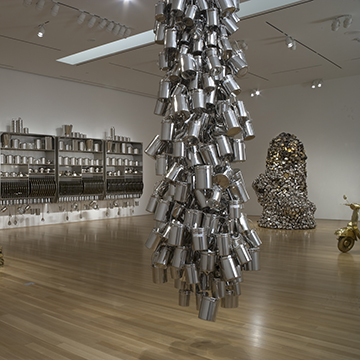Distant Nearness
Rina Banerjee · Subodh Gupta · Bharti Kher
Distant Nearness will feature the work of Rina Banerjee, Subodh Gupta and Bharti Kher, three contemporary artists from India. An immense and populous land, India’s cultural impact is being felt globally, through film, music, literature and visual arts that reach far outside the country’s borders, and, more directly, through a long and successful emigration policy to Great Britain, Canada, Australia, South Africa and the United States.
Rina Banerjee’s A World at a Loss, 2007, is a fantastical floor to ceiling accumulation that brings together diverse objects like a glass lantern, a globe, black sand, wooden altar, artificial grass, twenty four pink fans, and an ostrich egg. The range of materials Banerjee uses to create her absurd forms mixes antique and modern, organic and artificial, native and foreign.
Born in 1963 in Calcutta, India, yet living most of her life in London and New York, Banerjee produces works which express a symbiosis of several cultures and articulate conflicts associated with migration. Beneath her exuberant colors and flowing, organic forms, Banerjee creates a sinister and entangled web of images, addressing themes of colonialization, exploitation, commercialization, and modern globalization. As an artist split between two worlds, she questions both Anglo-Saxon and Indian ways of life. Banerjee’s work was included in the prestigious Whitney Biennial in 2000 at the Whitney Museum of American Art.
Subodh Gupta, who was born in 1964 in Khagaul (Bihar), India and currently lives in Gurgaon (New Delhi) India, focuses upon the frisson between traditional rural life in India and the transformative pressures of globalization. Gupta renders baggage carriers (ubiquitous to airports) in bronze, as monuments to the migratory global economy in which thousands of Indian workers participate every day. Traveling abroad, often to the Gulf States, where they live in cramped quarters, these workers return home after months of labor; their possessions bound in satchels or cardboard boxes.
In contrast to these symbols of India’s presence in the world economy, Gupta employs common stainless steel tableware in many of his sculptures – an ode to kitchen utensils fundamental to most of India’s population. As Gupta states: “I am particularly fond of kitchens. When I was a child, I considered it a place of worship, a kind of temple. For me, it is a place full of spirituality. But of course, it is also a symbol of daily life, as 90% of Indians use kitchen utensils made of stainless steel.”
Gupta has been included in a growing number of international exhibitions from the Moscow Biennale of Contemporary Art to the Museum of Contemporary Art, Chicago.
Bharti Kher, born in 1969 in London and living in Gurgaon (New Delhi), India since the early 1990s, frequently employs bindi as a central motif in her work. Derived from bindu, the Sanskrit word for a dot or a point, the bindi is a forehead decoration. Conceptually, Kher was struck by the synchronized, pan-Indian choreography by which millions of women prepare for their day with the same gesture, that of applying the bindi to their foreheads. She also saw, through eyes attuned to Op-Art, Pop Art, and Minimalism, that differential arrays of bindis could imbue abstraction with social content.
Animals, a recurring theme in Kher’s sculpture, serve as a metaphor for transformation and as warnings of our growing disconnect with nature. Solarium Series, 2007, is a tree of hallucinations, its branches bearing 500 fruits - and each fruit is a head, either human, gnomish, angelic, animal or that of a chimera.
Distant Nearness will be the first American Museum exhibition for Bharti Kher.




